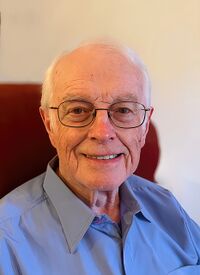Jim Blair
BLAIR, James Ross, BSc (Hons, Edinburgh) MSc PhD (Cantab) FIEAust (1939 - )
James Ross Blair (Jim Blair) was born on 13 May 1939 in Dunfermline, Scotland, to Ian Ross Blair and Elizabeth Arnotette Blair (nee Haldane). During his primary school years at Crook of Devon Primary School, he lived in Powmill, a small village in Clackmannanshire.
He attended Dollar Academy until 1957, where his aptitude for applied mathematics shaped his future career. He graduated with Honours in Mechanical Engineering from the University of Edinburgh, followed by a Diploma in Applied Dynamics (later M.Sc.) in 1961.
Jim began his professional career at Rolls Royce in Glasgow, specialising in the testing and fatigue analysis of aircraft aero-engine compressor blades.
In 1963, taking advantage of a year’s leave, he accepted a temporary lectureship in Mechanical Engineering at the University of Western Australia (UWA). Choosing to remain in Perth, he became a permanent member of the Mechanical Engineering Department, developing early expertise in computing and dynamic simulation.
In 1968, he married Helen (nee Helen Marjorie Jeanes), an English graduate and schoolteacher who played a key role in refining his technical writing skills.
Awarded a Gledden Fellowship in 1969, and with the support of Professor David Allen-Williams, Jim undertook doctoral studies at the University of Cambridge, working on dynamic modelling and control of paper board manufacturing machinery. His research successfully produced a control strategy to maintain uniform product thickness.
Returning to UWA in 1972, Jim applied his Cambridge training to industry-focused research. His projects included modelling the Bayer Process in alumina production for Alcoa. More importantly ultimately, and, in partnership with Dr Duncan Steven from the Electrical Department, he conducting conducted real-time dynamic analysis of long iron ore trains in the Pilbara to develop strategies that to prevented coupler failures. He also contributed to the development of an automatic sheep shearing machine.
In 1980, Jim co-found ACET with colleagues from UWA, serving as its CEO. The company conducted advanced studies of train behaviour and developed a train-driving simulator, and manufactured equipment for the mining sector.
Following the economic downturn of late 1980s, ACET was acquired in 1990 by Futuris Ltd and merged with two other rail engineering companies to form GEMCO. Jim joined GEMCO as Technical Director, where he gained extensive experience in rail industry management.
In 1996 he founded his own consultancy, JRB Engineering, and was soon joined by former student and colleagues Lloyd Lissiman and Roy Leslie. and later by hHis son Stewart, a recent Mechanical Engineering graduate. , also joined the company. This consultancy evolved into MRX technologies, which grew into a leading provider of rail monitoring and diagnostic systems, developing innovative technologies, including automated train control, tarin components measurement systems, and high-speed rail defect detection and crack measurement.
Under Jim’s leadership, MRX grew to around 150 staff before being acquired by Siemens in 2017. He, his son and the entire team transferred to Siemens, ensuring continuity of their work. Jim remained with the company until his retirement in 2020, contributing technical leadership and mentoring next generation of engineers.
Jim joined the Institution of Engineers, Australia in 1969 and was later elected as a Fellow. In 1990, Jim was awarded the A G M Michell Medal, the preeminent annual award by the Mechanical Engineering College of Engineers Australia.
In retirement, he stays active with farming and continues his lifelong passion for hands-on engineering from fabricating farm machinery to programming small microcontrollers.
Biography compiled by Fatima Kazemi and James Trevelyan, June 2025, Western Australia Division
References:
Trevelyan, James (2025) Personal Communication
Journal of the Institution of Engineers, Australia, vol 62 no 24 Dec 7, 1990 pp 33-34
